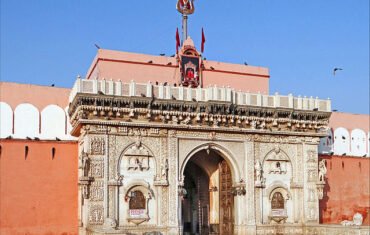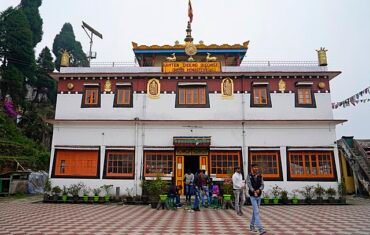Humayun Tomb, Delhi is a magnificent and majestic mausoleum that was built by the Mughal Emperor Humayun’s widow, Empress Bega Begum, in 1570. It is the first garden-tomb on the Indian subcontinent, and a precursor of the famous Taj Mahal. It is also a UNESCO World Heritage Site, as it showcases the rich and diverse cultural and historical heritage of India. The tomb is located in Nizamuddin East, Delhi, near the shrine of the 14th century Sufi saint, Nizamuddin Auliya.
The tomb is surrounded by a beautiful and serene garden, which is divided into four quadrants by water channels. The tomb is an octagonal structure with a high double dome and four arched entrances. The tomb is made of red sandstone with white and black marble inlays. The tomb houses the graves of Humayun and his family members, as well as other Mughal emperors and nobles. The tomb is a masterpiece of Mughal architecture, art and engineering, and a symbol of love and devotion. Visit during Delhi Local sightseeing By cab
Overview of Humayun Tomb

Humayun Tomb, Delhi is a stunning and splendid monument that stands out in the landscape of Delhi. The tomb was commissioned by Empress Bega Begum, also known as Haji Begum, who was the first wife and chief consort of Humayun. She was deeply devoted to her husband, and wanted to build a grand and glorious tomb for him after his death in 1556. She hired Persian architects Mirak Mirza Ghiyas and his son Sayyid Muhammad to design and construct the tomb.
The construction began in 1565 and was completed in 1570. The tomb was inspired by the Gur-e Amir, the tomb of Timur in Samarkand, who was an ancestor of Humayun. The tomb was also influenced by Persian and Indian styles of architecture. The tomb was the first garden-tomb on the Indian subcontinent, which set a trend for later Mughal mausoleums. The tomb was also the first structure to use red sandstone on such a large scale.

The tomb is located in a complex of 27.04 hectares, which includes other 16th century Mughal garden-tombs such as Nila Gumbad, Isa Khan’s Tomb, Bu Halima’s Tomb, Afsarwala Tomb, Barber’s Tomb and Arab Serai. The complex also has several mosques, pavilions, gateways and walls. The complex is situated near the Dina-panah Citadel or Purana Qila (Old Fort), which was founded by Humayun in 1538. The complex is also close to the shrine of Nizamuddin Auliya, who was a revered Sufi saint of Delhi. The proximity to the saint’s grave made the site auspicious for burial, and many Mughal emperors and nobles chose to be buried here.
The tomb is entered from three sides: east, west and south. The main entrance is on the south side, which has a large arched gateway with an inscription of Quranic verses. The gateway leads to a long paved path that crosses a bridge over a water channel. The path leads to another gateway that opens into the garden of the tomb. The garden is divided into four quadrants by water channels that represent the four rivers of paradise in Islam. Each quadrant has walkways lined with trees and flower beds. In the centre of each quadrant, there is a raised platform with a water tank.

The tomb stands on a high platform in the centre of the garden. It has an octagonal plan with four long sides and four chamfered corners. It has four arched entrances on each side, with the south one being the largest and most ornate. The entrances lead to an octagonal chamber that houses the cenotaph of Humayun. The chamber has vaulted ceilings with intricate patterns and inscriptions. The chamber also has niches that contain smaller cenotaphs of other family members of Humayun.
The tomb is surmounted by a high double dome made of white marble with black stripes. The dome has a brass finial on top that acts as a lightning conductor. The dome is flanked by four pillared kiosks or chhatris on each corner of the platform. The chhatris have smaller domes
How to Reach Humayun Tomb

Humayun Tomb, Delhi is located on Mathura Road in Nizamuddin East, Delhi. It is easily accessible by metro, bus, auto-rickshaw or taxi. The nearest metro station is JLN Stadium on the Violet Line, which is about 2 km away from the tomb. From there, one can take an auto-rickshaw or a cycle-rickshaw to the tomb.
Humayun Tomb, Delhi is open to public from 7:00 am to 5:00 pm on all days except national holidays and special occasions as notified by the authorities. The entry fee for Indian visitors is Rs 30 per person, while for foreign visitors it is Rs 500 per person. There is no charge for children below 15 years of age. There is also a nominal fee for photography (Rs 25) and video filming (Rs 100).
Significance of Humayun Tomb
Humayun Tomb, Delhi is not only a splendid and majestic monument but also a sacred and spiritual site that represents the Mughal dynasty and its culture. It is a place where the Mughal emperors and their family members are buried, along with other Mughal nobles and dignitaries. It is a place where the Mughal history and heritage are preserved and displayed. It is a place where the Mughal art and architecture are showcased and admired.
Humayun Tomb, Delhi is also a place that reflects the vision and mission of its patroness, Empress Bega Begum, who was a devoted and loyal wife of Humayun. She was a woman who wanted to honour her husband’s memory and legacy by building a grand and glorious tomb for him. She was a woman who wanted to express her love and affection for her husband by creating a beautiful and serene garden for him. She was a woman who wanted to demonstrate her piety and faith by choosing a site near the shrine of a saint for him.
Humayun Tomb, Delhi is a place that you should visit when you are in Delhi. It is a place that will enchant you with its beauty and elegance. It is a place that will educate you with its history and culture. It is a place that will connect you with the Mughal dynasty and its spirit.
FAQ’s
Here are some of the frequently asked questions about Humayun’s Tomb and their answers:
- Q: How long does it take to visit Humayun Tomb?
- A: It depends on how much time you want to spend in the tomb and its complex. Generally, it takes about two to three hours to visit Humayun Tomb and enjoy its beauty and splendor.
- Q: What are the best times to visit Humayun Tomb?
- A: The best times to visit Humayun Tomb are during sunrise and sunset, when you can see the tomb in its full glory and charm. You can also visit during festivals such as Holi, Diwali and Eid, when you can see various cultural events and celebrations at the tomb.
Conclusion
Humayun Tomb, Delhi is a magnificent and majestic monument that stands out in the landscape of Delhi. It is a splendid and elegant mausoleum that was built by the Mughal Emperor Humayun’s widow, Empress Bega Begum, in 1570. It is the first garden-tomb on the Indian subcontinent, and a precursor of the famous Taj Mahal. It is also a UNESCO World Heritage Site, as it showcases the rich and diverse cultural and historical heritage of India.
Humayun Tomb is surrounded by a beautiful and serene garden, which is divided into four quadrants by water channels. The tomb is an octagonal structure with a high double dome and four arched entrances. The tomb is made of red sandstone with white and black marble inlays. The tomb houses the graves of Humayun and his family members, as well as other Mughal emperors and nobles. The tomb is a masterpiece of Mughal architecture, art and engineering, and a symbol of love and devotion.
Humayun Tomb, Delhi is a place that you should visit when you are in Delhi. It is a place that will enchant you with its beauty and elegance. It is a place that will educate you with its history and culture. It is a place that will connect you with the Mughal dynasty and its spirit. Humayun’s Tomb, Delhi is a wonder of Mughal architecture that you should not miss.











Comments are closed.